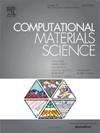The influence of Al concentration on the structural stability, electronic and optical properties of InN semiconductor from first-principles study
IF 3.1
3区 材料科学
Q2 MATERIALS SCIENCE, MULTIDISCIPLINARY
引用次数: 0
Abstract
Although InN is a promising semiconductor material because of the narrow band gap and high electronic mobility capacity, the influence of Al-doped concentration on the structural, electronic and optical properties of InN semiconductor is unclear. To improve the electronic and optical properties of InN semiconductor, here, we apply the first-principles method to study the influence of Al-doped concentration on the structural stability, electronic and optical properties of InN semiconductor. The calculated result shows that these Al-doped InN semiconductors are thermodynamic stability due to the negative doped formation energy. Here, the thermodynamic stability of the Al-doped InN becomes weak with increasing Al-doped concentration. In particular, three Al-doped InN nitrides are dynamical stability based on the analysis of phonon dispersion. Furthermore, it is found that the calculated band gap of the Al-doped InN is bigger than the parent InN because the additive Al results in band separation between the N-2p state and In-5p state near the Fermi level (EF). Compared to the parent InN, the additive Al results in adsorption peak migration from the ultraviolet region to the visible light region. In addition, the Al-doping is beneficial to improve the storage optical properties of InN compared to the parent InN. Therefore, we believe that the metal Al can improve the electronic and optical properties of InN semiconductor.

求助全文
约1分钟内获得全文
求助全文
来源期刊

Computational Materials Science
工程技术-材料科学:综合
CiteScore
6.50
自引率
6.10%
发文量
665
审稿时长
26 days
期刊介绍:
The goal of Computational Materials Science is to report on results that provide new or unique insights into, or significantly expand our understanding of, the properties of materials or phenomena associated with their design, synthesis, processing, characterization, and utilization. To be relevant to the journal, the results should be applied or applicable to specific material systems that are discussed within the submission.
 求助内容:
求助内容: 应助结果提醒方式:
应助结果提醒方式:


